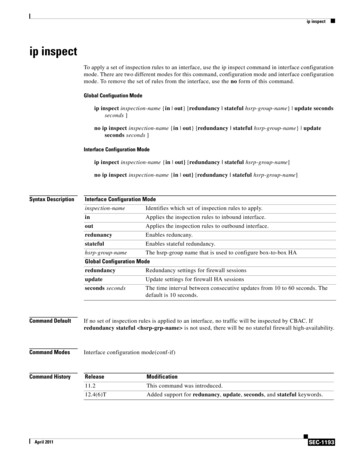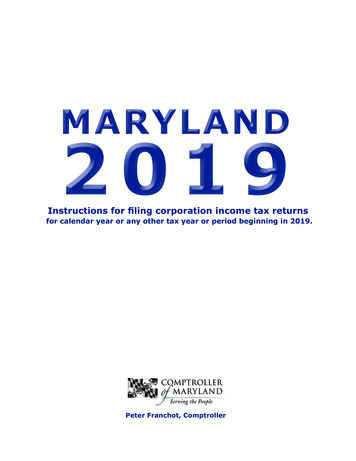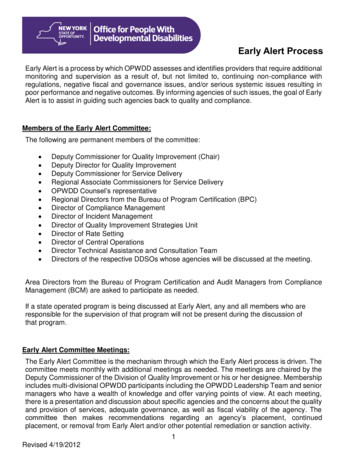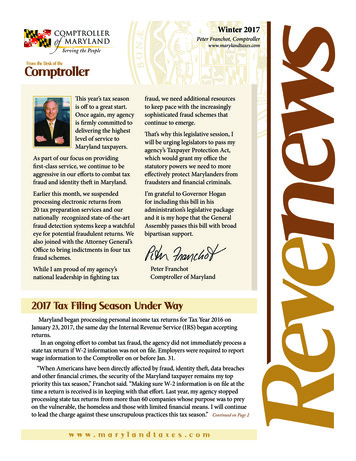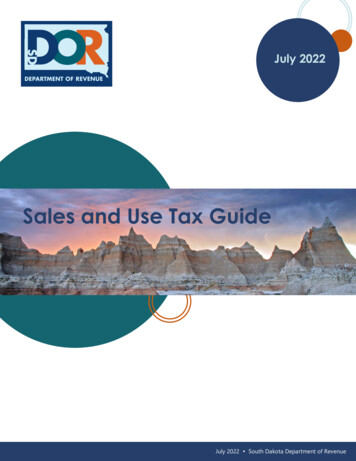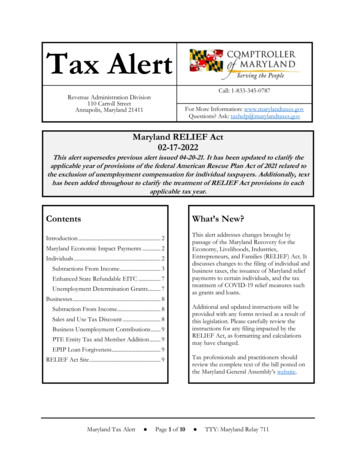
Transcription
Tax AlertCall: 1-833-345-0787Revenue Administration Division110 Carroll StreetAnnapolis, Maryland 21411For More Information: www.marylandtaxes.govQuestions? Ask: taxhelp@marylandtaxes.govMaryland RELIEF Act02-17-2022This alert supersedes previous alert issued 04-20-21. It has been updated to clarify theapplicable year of provisions of the federal American Rescue Plan Act of 2021 related tothe exclusion of unemployment compensation for individual taxpayers. Additionally, texthas been added throughout to clarify the treatment of RELIEF Act provisions in eachapplicable tax year.ContentsWhat’s New?Introduction . 2Maryland Economic Impact Payments . 2Individuals . 2Subtractions From Income . 3Enhanced State Refundable EITC . 7Unemployment Determination Grants . 7Businesses . 8Subtraction From Income. 8Sales and Use Tax Discount . 8Business Unemployment Contributions . 9PTE Entity Tax and Member Addition . 9EPIP Loan Forgiveness. 9RELIEF Act Site . 9Maryland Tax Alert Page 1 of 10This alert addresses changes brought bypassage of the Maryland Recovery for theEconomy, Livelihoods, Industries,Entrepreneurs, and Families (RELIEF) Act. Itdiscusses changes to the filing of individual andbusiness taxes, the issuance of Maryland reliefpayments to certain individuals, and the taxtreatment of COVID-19 relief measures suchas grants and loans.Additional and updated instructions will beprovided with any forms revised as a result ofthis legislation. Please carefully review theinstructions for any filing impacted by theRELIEF Act, as formatting and calculationsmay have changed.Tax professionals and practitioners shouldreview the complete text of the bill posted onthe Maryland General Assembly’s website. TTY: Maryland Relay 711
IntroductionOn February 15, 2021, Governor Lawrence J. Hogan, Jr. signed Senate Bill 496, Recovery for the Economy,Livelihoods, Industries, Entrepreneurs, and Families Act, referred to as the RELIEF Act into law. The bill’spurpose is to relieve some of the adverse economic effects of the coronavirus pandemic. To that end, theRELIEF Act authorizes economic impact payments to certain Maryland residents, as well as separatelyproviding for adjustments to both individual and business tax filings.The Comptroller began accepting tax year 2020 returns for processing prior to the enactment of the RELIEFAct. Due to the emergency nature of this bill, both individual and business tax forms have been created ormodified to account for its provisions. The Comptroller strongly recommends any filer impacted by this billdelay filing until revised forms for tax year 2020 have been published, in order to take full advantage of therelief offered.The guidance provided in this Tax Alert should be considered secondary to any tax forms, filing instructions,or regulations promulgated by the Comptroller of Maryland.Maryland Economic Impact PaymentsIn order to assist Maryland citizens, the RELIEF Act authorizes economic impact payments (EIP) toindividuals who received the Maryland earned income tax credit (EITC) in tax year 2019. With the exceptionof some members of the military, these payments are limited to current Maryland residents.1 These paymentswill not be subject to Maryland tax; however, the payments might be subject to federal income tax.The amount of the payments is determined as follows: Individual taxpayers will receive an economic impact payment of 300.Spouses who filed a joint return, surviving spouses, and heads of household as defined by theInternal Revenue Code will receive an economic impact payment of 500.For taxpayers who received their tax refund by direct deposit, the state economic impact payment will be sentto the same bank account. If the payment is rejected, a paper check will be issued to the taxpayer’s address onfile. Eligible individuals who received their 2019 income tax refund by paper check or who received a 2019State earned income tax credit but did not receive a 2019 refund will receive their EIP by paper check.Except as relating to child support, EIP funds are not subject to garnishment, holds, liens, or setoffs by ataxpayer’s financial institution.IndividualsThe residency status of active-duty military members shall follow the ordinary rules; Maryland residents presentlydeployed out of state will still be treated as residents for purpose of EIP eligibility.1Maryland Tax Alert Page 2 of 10 TTY: Maryland Relay 711
Subtractions From IncomeThe RELIEF Act allows Maryland taxpayers to subtract certain amounts from their federal adjusted grossincome (FAGI). In order to be eligible for the subtraction, these amounts must be included in a taxpayer’sFAGI for the same year. Please note certain payroll protection programs under the federal Coronavirus Aid,Relief, and Economic Security (CARES) Act have already been excluded from FAGI under federal law.Additionally, certain portions of unemployment compensation have been excluded from FAGI. As theseamounts are not included in a taxpayer’s FAGI, they are not eligible for subtraction on the Maryland return.In order to claim these subtractions for tax year 2020, individuals must complete Maryland Form 502LU andfile it along with their return. For tax year 2021, the subtractions have been incorporated into the income taxreturn and should be claimed like other subtractions using Form 502SU.The following subtractions from income are available under the RELIEF Act for tax years 2020 and 2021: Unemployment Benefits. To the extent included in federal adjusted gross income, qualifiedtaxpayers may subtract the amount of unemployment benefits received2 during the taxable year ontheir Maryland return in tax years 2020 and 2021. This subtraction is only available to taxpayers witha filing status of single, married filing separate, or dependent with FAGI that does not exceed 75,000, and filers with married filing joint, head of household, or surviving spouse status with aFAGI that does not exceed 100,000.On March 11, 2021, the American Rescue Plan Act (ARPA) was signed into law. ARPA permitsexclusion of up to 10,200 in unemployment compensation from FAGI for tax year 2020 only. Formarried taxpayers, each spouse receiving unemployment compensation may exclude up to 10,200 oftheir own unemployment compensation for tax year 2020.The 2020 federal exclusion is limited to taxpayers whose modified adjusted gross income is less than 150,000.3 The same 150,000 modified adjusted gross income cap applies to both single filers andmarried taxpayers filing jointly; married filing joint taxpayers may not double the modified adjustedgross income cap.For tax year 2020, any amount of unemployment compensation in excess of 10,200 that is includedat the federal level is eligible for the subtraction at the Maryland level, subject to Maryland’s incomecaps for the subtraction. Taxpayers who qualify for the federal exclusion, but do not qualify for theMaryland subtraction, need not add back the amount excluded from FAGI; the exclusion flows tothe Maryland return.For tax year 2021, any amount of unemployment compensation from Maryland or a jurisdiction witha reciprocal taxation agreement that is included in FAGI of a qualifying taxpayer is eligible for thesubtraction.Unemployment compensation from Maryland or from a jurisdiction with which the State has a reciprocal taxationagreement may be subtracted. Maryland has reciprocal agreements with Pennsylvania, Virginia, West Virginia, and theDistrict of Columbia.23Modified adjusted gross income is calculated without including unemployment compensation.Maryland Tax Alert Page 3 of 10 TTY: Maryland Relay 711
Examples for Tax Year 20201. A taxpayer filing single has modified adjusted gross income of 54,000, and received 20,000 of unemployment compensation. 10,200 may be excluded from FAGI on the federalreturn; 9,800 is included in FAGI. Their FAGI is 63,800. Because 9,800 is included in FAGI,and their FAGI is less than 75,000, the Maryland unemployment compensation subtraction is 9,800.2. A taxpayer filing single has modified adjusted gross income of 69,000, and received 5,000 ofunemployment compensation. The entire 5,000 may be excluded from FAGI on the federalreturn; no unemployment compensation is included in FAGI. Their FAGI is 69,000. Becauseno amount of unemployment compensation is included in FAGI, they are not eligible for theMaryland unemployment compensation subtraction, even though their FAGI is under 75,000.3. A taxpayer filing single has modified adjusted gross income of 69,000, and received 20,000 ofunemployment compensation. 10,200 may be excluded from FAGI on the federal return; 9,800 is included in FAGI. Their FAGI is 78,800. Because their FAGI exceeds 75,000, theyare not eligible for the Maryland unemployment compensation subtraction, even though 9,800is included in FAGI. No addition modification is required to add-back the unemploymentcompensation excluded from FAGI, even though the taxpayer’s FAGI exceeds the Marylandincome threshold for the subtraction. The federal exclusion flows to the Maryland return.4. A taxpayer filing single has modified adjusted gross income of 85,000, and received 15,000 ofunemployment compensation. 10,200 may be excluded from FAGI on the federalreturn; 4,800 of unemployment compensation is included in FAGI. Their FAGI is 89,800. Because their FAGI is above 75,000, they are not eligible for the Marylandunemployment compensation subtraction, even though 4,800 of unemployment compensationwas included in FAGI. No addition modification is required to add back the unemploymentcompensation excluded from FAGI, even though the taxpayer’s FAGI exceeds the Marylandincome threshold for the subtraction. The federal exclusion flows to the Maryland return.5. A taxpayer filing single has modified adjusted gross income of 160,000, and received 5,000 ofunemployment compensation. None of the unemployment compensation is excludable fromFAGI because their income exceeds the federal threshold; all 5,000 is included in FAGI.Because the taxpayer’s FAGI is over 75,000, the taxpayer is not eligible for the Marylandunemployment compensation subtraction, even though 5,000 of unemployment compensationwas included in FAGI.6. Married taxpayers filing jointly have modified adjusted gross income of 70,000. Spouse Areceived 20,000 of unemployment compensation; Spouse B received 5,000 of unemploymentcompensation. 10,200 of Spouse A’s unemployment compensation may be excluded fromFAGI; all 5,000 of Spouse B’s unemployment compensation may be excluded fromFAGI. 9,800 of unemployment compensation is included in FAGI. Their FAGI is 79,800.Because their FAGI is under 100,000, they are eligible for a Maryland unemploymentcompensation subtraction of 9,800, the amount of unemployment compensation included inFAGI.7. Married taxpayers filing jointly have modified adjusted gross income of 80,000. Spouse Areceived 20,000 of unemployment compensation; Spouse B received 15,000 of unemploymentcompensation. 10,200 of Spouse A’s unemployment compensation may be excluded fromMaryland Tax Alert Page 4 of 10 TTY: Maryland Relay 711
FAGI; 10,200 of Spouse B’s unemployment compensation may be excluded from FAGI. 14,600 of unemployment compensation ( 9,800 of Spouse A’s 4,800 of Spouse B's) isincluded in FAGI. Their FAGI is 94,600. Because their FAGI is under 100,000, they areeligible for a Maryland unemployment compensation subtraction of 14,600, the amount ofunemployment compensation included in FAGI.8. Married taxpayers filing jointly have modified adjusted gross income of 95,000. Spouse Areceived 20,000 of unemployment compensation; Spouse B received 5,000 of unemploymentcompensation. 10,200 of Spouse A’s unemployment compensation may be excluded fromFAGI; all 5,000 of Spouse B’s unemployment compensation may be excluded fromFAGI. 9,800 of unemployment compensation is included in FAGI. Their FAGI is 104,800.Because their FAGI is over 100,000, they are not eligible for the Maryland unemploymentcompensation subtraction, even though 9,800 of unemployment compensation is included inFAGI. No addition modification is required to add back the unemployment compensationexcluded from FAGI, even though the taxpayer’s FAGI exceeds the Maryland income thresholdfor the subtraction. The federal exclusion flows to the Maryland return.9. Married taxpayers filing jointly have modified adjusted gross income of 130,000. Spouse Areceived 20,000 of unemployment compensation; Spouse B received 5,000 of unemploymentcompensation. 10,200 of Spouse A’s unemployment compensation may be excluded fromFAGI; all 5,000 of Spouse B’s unemployment compensation may be excluded from FAGI. 9,800 of unemployment compensation is included in FAGI. Their FAGI is 114,800. Becausetheir FAGI is over 100,000, they are not eligible for the Maryland unemployment compensationsubtraction.10. Married taxpayers filing jointly have modified adjusted gross income of 160,000. Spouse Areceived 20,000 of unemployment compensation; Spouse B received 5,000 of unemploymentcompensation. None of their unemployment compensation is excludable from FAGI; all 25,000is included in FAGI. Because their FAGI is over 100,000, they are not eligible for the Marylandunemployment compensation subtraction, even though 25,000 of unemployment compensationis included in FAGI.The IRS has indicated that it will adjust the 2020 federal returns of those taxpayers who filed prior tothe enactment of the ARPA to allow them the benefit of the federal exclusion of unemploymentcompensation. Should such a federal adjustment bring a taxpayer’s FAGI to below the threshold forMaryland’s unemployment compensation subtraction, and should the taxpayer’s adjusted FAGIinclude some unemployment compensation, the taxpayer must file an amended Maryland return toget the benefit of the Maryland subtraction. The Comptroller’s office will not make adjustments onthe taxpayers’ behalf.For example, a single taxpayer with FAGI of 80,000, which included 20,000 of unemploymentcompensation, filed federal and State returns for tax year 2020 prior to the enactment of ARPA. Atthe time of filing, there was no federal exclusion of unemployment compensation, so FAGI was 80,000. The taxpayer is not eligible for the Maryland unemployment subtraction, because FAGIexceeds 75,000. After the passage of ARPA, this taxpayer may exclude 10,200 of unemploymentcompensation from FAGI. The IRS makes the adjustment, and the new FAGI is 69,800. Taxpayeris now eligible for the Maryland unemployment compensation subtraction. Taxpayer must amend theMaryland return to take the subtraction of 9,800.Maryland Tax Alert Page 5 of 10 TTY: Maryland Relay 711
Examples for Tax Year 20211. A taxpayer filing single has modified adjusted gross income of 54,000, and received 20,000 of unemployment compensation. 20,000 is included in FAGI. Their FAGI is 74,000. Because their FAGI is less than 75,000, they may subtract all unemploymentcompensation. The Maryland unemployment compensation subtraction is 20,000.2. A taxpayer filing single has modified adjusted gross income of 69,000, and received 20,000 ofunemployment compensation. Their FAGI is 89,000. Because their FAGI exceeds 75,000,they are not eligible for the Maryland unemployment compensation subtraction.3. A taxpayer filing single has modified adjusted gross income of 85,000, and received 15,000 ofunemployment compensation. Their FAGI is 100,000. Because their FAGI is above 75,000,they are not eligible for the Maryland unemployment compensation subtraction.4. Married taxpayers filing jointly have modified adjusted gross income of 70,000. Spouse Areceived 20,000 of unemployment compensation; Spouse B received 5,000 of unemploymentcompensation. Their FAGI is 95,000. Because their FAGI is under 100,000, they are eligiblefor a Maryland unemployment compensation subtraction of 25,000, the amount ofunemployment compensation included in FAGI.5. Married taxpayers filing jointly have modified adjusted gross income of 80,000. Spouse Areceived 20,000 of unemployment compensation; Spouse B received 15,000 of unemploymentcompensation. Their FAGI is 115,000. Because their FAGI is over 100,000, they are noteligible for the Maryland unemployment compensation subtraction.6. Married taxpayers filing jointly have modified adjusted gross income of 130,000. Spouse Areceived 20,000 of unemployment compensation; Spouse B received 5,000 of unemploymentcompensation. Their FAGI is 155,000. Because their FAGI is over 100,000, they are noteligible for the Maryland unemployment compensation subtraction. Coronavirus Relief Payments: To the extent included in federal adjusted gross income, taxpayersmay subtract coronavirus relief payments on their Maryland return in Tax Years 2020 and 2021.Coronavirus relief payments include grants or loans applied for after March 5, 2020, that wereprovided to assist with coronavirus-related economic hardships. The subtraction also includes anycoronavirus relief loan amounts that were forgiven. The taxpayer must submit a 1099 as proof of thegrant income or loan forgiveness amount along with Form 502LU (tax year 2020), or with theincome tax return (tax year 2021). Grant payments or loan forgiveness received in 2020 must besubtracted on the 2020 Maryland return. Grant payments or loan forgiveness received in 2021 mustbe subtracted on the 2021 Maryland return.The Comptroller has published a list of COVID-19 relief payments eligible for this subtraction atmarylandtaxes.gov. This list is subject to ongoing maintenance as state, local, and municipalauthorities report additional eligible programs. Please contact the Comptroller regarding anypotentially eligible relief payment absent from this list by emailing taxhelp@marylandtaxes.gov.Additionally, the RELIEF Act provides for a subtraction from income for Maryland economic impactpayments, discussed above, for tax year 2021:Maryland Tax Alert Page 6 of 10 TTY: Maryland Relay 711
State Economic Impact Payments: To the extent included in federal adjusted gross income,taxpayers may subtract Maryland economic impact payments on their Maryland return. Thissubtraction applies to tax years beginning after December 31, 2020 but before January 1, 2022. Pleasenote, because State economic impact payments are being issued in tax year 2021, this subtraction willbe taken on returns filed for tax year 2021 during calendar year 2022.The subtraction for State economic impact payments is incorporated into the income tax forms fortax year 2021, and is claimed like other subtractions using Form 502SUEnhanced State Refundable EITCMaryland filers claiming the federal EITC may also be eligible for a refund of a percentage of this amountthrough their Maryland tax return. The RELIEF Act increases this percentage from 28% for tax year 2019 to45% for tax years 2020 through 2022, resulting in an increased refund amount for some taxpayers.Additionally, for tax years 2020 through 2022, taxpayers without qualifying children will be allowed to use thefull amount of their federal EITC as a refundable credit against Maryland income tax, up to a maximum of 530.These changes do not require any action on behalf of taxpayers or preparers and will incorporated into therevised forms and instructions pursuant to passage of the Act. Individuals who qualify for the enhanced stateREIC but who filed tax year 2020 returns before March 5, 2021 need not take any action. The Comptrollerwill make any adjustment necessary based on the law change and will adjust the amount of the credit,including sending an additional refund if applicable.Unemployment Determination GrantsThe RELIEF Act established the Recovery Now Fund for the purpose of distributing certain funds to assistMaryland enterprises affected by the COVID-19 pandemic. Additionally, the Recovery Now Fund providesfor a 1,000 grant to any individual whose claim for unemployment benefits is pending a determination ofeligibility and has been in adjudication for at least 30 days, except for a claim where the failure to determineeligibility is related to an allegation of fraud.The Maryland Department of Labor shall determine who is eligible for this grant and provide lists ofqualifying individuals to the Comptroller’s Office, the first of which is due by March 3, 2021. On or aroundthat date, the Comptroller’s Office shall publish additional information relating to the disbursement of thesegrants. The Maryland Department of Labor shall provide subsequent lists to the Office of the Comptroller onApril 5, 2021, May 5, 2021, June 3, and July 6, 2021.4An unemployment determination grant is considered a coronavirus relief payment, and, to the extent includedin FAGI for tax year 2020 or 2021, the payment is eligible for the coronavirus relief payment subtraction onthe Maryland return for the year in which the payment was received.In the version of this Tax Alert published on February 16, 2021, June 3 was inadvertently omitted from this paragraph,and the fourth date was erroneously listed as July 5, instead of July 6.4Maryland Tax Alert Page 7 of 10 TTY: Maryland Relay 711
BusinessesSubtraction From IncomeLike the subtractions from income available to individuals, the RELIEF Act allows certain businesses tosubtract certain amounts included in their federal taxable income. In order to be eligible for the subtraction,these amounts must be included in a taxpayer’s federal taxable income for the same year.For tax year 2020, Corporations claim this subtraction on form 500, Schedule 500LU. For tax year 2021, thesubtraction is incorporated into the income tax form, and is claimed like other subtractions. Corporate taxreturns include instructions on how to claim this subtraction.Pass-through entities are reminded that subtractions must be passed to members on Schedule K-1. For moreinformation, see Maryland Schedule K-1 (510) and instructions.The subtraction from income is available under the RELIEF Act for tax years 2020 and 2021: Coronavirus Relief Payments: To the extent included in federal taxable income, corporations maysubtract coronavirus relief payments on their 2020 and 2021 Maryland returns. Coronavirus reliefpayments includes grants or loans applied for after March 5, 2020, that were provided to assist withcoronavirus-related economic hardships. The subtraction also includes any coronavirus relief loanamounts that were forgiven. Grant payments or loan forgiveness received in 2020 must be subtractedon the 2020 Maryland return. Grant payments or loan forgiveness received in 2021 must besubtracted on the 2021 Maryland return.The Comptroller has published a list of COVID-19 relief payments eligible for this subtraction atmarylandtaxes.gov. This list is subject to ongoing maintenance as state, local, and municipalauthorities report additional eligible programs. Please contact the Comptroller’s Office regarding anypotentially eligible relief payment absent from this list by emailing taxhelp@marylandtaxes.gov.Sales and Use Tax DiscountThe RELIEF Act provides for an alternative credit against the gross amount of sales and use tax owed bysome vendors. This credit is available for each of the three (3) following months: March, April, and May2021. In order to qualify for this credit, all of the following conditions must be true: The vendor’s return is timely filed;The vendor’s return is filed using the Comptroller’s bFile system;The gross amount of sales and use tax required to be paid with the return does not exceed 6,000;andThe vendor has not taken the credit allowed under § 11-105 of the Tax-General Article (also knownas the vendor discount) for the same period.Additionally, the credit does not apply to sales by a marketplace seller, as defined under § 11-101 of the TaxGeneral Article. Marketplace facilitators reporting sales by a marketplace seller are not eligible to claim thecredit.Maryland Tax Alert Page 8 of 10 TTY: Maryland Relay 711
The credit amount is equal to the lesser of 3,000 or the sales and use tax collected during the month forwhich the vendor qualifies for the credit. The Comptroller’s Office shall issue revised forms and instructionsconsistent with the creation of this credit.Please note the Comptroller has extended the filing deadlines for sales and use tax returns. The RELIEF Actcredit applies to returns for March, April, and May, 2021. The March return is due by April 20, 2021. TheComptroller had extended the deadline to file sales and use tax returns that are due between January 20, 2021and April 14, 2021 to April 15, 2021. The first due date for which the RELIEF credit is available is April 20,2021 therefore, the RELIEF Act credit is not affected by the extended sales and use tax deadline. For moreinformation on the extension, see Tax Alert 01-06-21.Business Unemployment ContributionsThe RELIEF Act adjusts certain business’ calculation of unemployment contributions. Questions regardingthis provision should addressed to the Department of Labor, Contributions Division, via their contactinformation here.PTE Entity Tax and Member AdditionThe RELIEF Act made certain changes to the pass-through entity tax election described in § 10-102.1, 10306, and 10-701.1 of the Tax-General Article. Members of pass-through entities electing this tax treatmentshould note the addition to income now required under § 10-205 of the Tax-General Article, which is equalto the amount of tax paid by the electing pass-through entity and is attributable to the member’s share. Fortax year 2020, affected members must take the addition using Form 502LU. For tax year 2021, the additionhas been incorporated into the form.Senate Bill 787 of the Acts of 2021 also contains provisions that impact how Electing pass-through entitiesdefine a pass-through entity’s taxable income. For more information on the definitional change to passthrough entity taxable income, please see Frequently Asked Questions the Maryland Pass-Through Entity TaxFor more information on this elective tax treatment by pass-through entities, see Maryland Income TaxAdministrative Release No. 6.EPIP Loan ForgivenessThe bill authorizes the Small Business Development Financing Authority to forgive loans from the EquityParticipation Investment Program (EPIP) by converting the loans to grants. Loans provided under theprogram during fiscal years 2021 and 2022 are eligible for forgiveness. More information on how to haveyour loan forgiven may be obtained by contacting the Maryland Small Business Development FinancingAuthority.RELIEF Act SiteMaryland Tax Alert Page 9 of 10 TTY: Maryland Relay 711
In order to support taxpayers and preparers navigating the changes brought by the RELIEF Act, theComptroller’s Office has prepared a dedicated site: MarylandTaxes.gov/ReliefAct. This site containsannouncements, updates, and frequently-asked-questions on a variety of topics covered by the Act.Additionally, it offers a tool which taxpayers may use to check their eligibility for an Economic ImpactPayment issued under the Act.Any further questions or concerns regarding the Comptroller’s Office’s implementation of the Act should bedirected to 1-833-345-0787 or our dedicated email address reliefact@marylandtaxes.govMaryland Tax Alert Page 10 of 10 TTY: Maryland Relay 711
Maryland Tax Alert Page 1 of 10 TTY: Maryland Relay 711 Tax Alert Revenue Administration Division 110 Carroll Street Annapolis, Maryland 21411 Call: 1-833-345-0787 For More Information: www.marylandtaxes.gov Questions? Ask: taxhelp@marylandtaxes.gov Maryland RELIEF Act 02-17-2022

